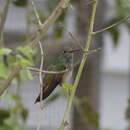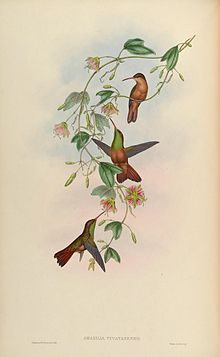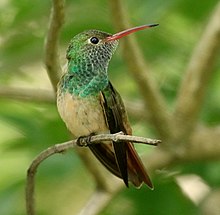pt-BR
nomes no trilho de navegação


Amazilia yucatanensis) ye una especie d'ave, que s'atopa dende'l baxu Valle del Ríu Grande, nel estremu sur de Texas, hasta la península de Yucatán, en Méxicu y Belice y Guatemala en Centroamérica.
Vive nes tierres baxes. Prefier los montes de coníferes y carbayos y les carbes en tierres grebes o a lo llargo de los cursos d'agua; alcuéntrase tamién nos güertos de cítricos. Ye una especie parcialmente migratoria y iverna a lo llargo de la mariña del Golfu, nos Estaos Xuníos, dende Texas hasta la península de la Florida.
Mide ente 10 y 11,5 cm de llargor[2] y pesa de 4 a 5 g. L'envés y la cabeza son de color verde oliva metálicu; el gargüelu ye de color verde metálicu doráu; la parte inferior del pechu ye de color ante leonado. La inferior de les ales ye de color blancu. La cola y les ales primaries son de color acoloratáu o ablondu y la cola encrúciase un pocu. El picu ye rectu y bien delgáu; ye de color coloráu, con una punta más escura. La fema tien un picu más escuru, y ye polo xeneral menos colorida que'l machu.[3][4]
Aliméntase del néctar de les flores,de preferencia les que tienen matices coloraos, usando una llingua llargo y estensible y. Amás atrapen inseutos na nala. Tanto machos como femes, de cualquier edá, defenden agresivamente los sitios d'alimentación, dientro del so territoriu.
La fema constrúi un nial, en forma de copa, nun llugar protexíu, xeneralmente una caña horizontal d'un parrotal o árbol. Pon dos güevos blancos.
 Esta páxina forma parte del wikiproyeutu Aves, un esfuerciu collaborativu col fin d'ameyorar y organizar tolos conteníos rellacionaos con esti tema. Visita la páxina d'alderique del proyeutu pa collaborar y facer entrugues o suxerencies.
Esta páxina forma parte del wikiproyeutu Aves, un esfuerciu collaborativu col fin d'ameyorar y organizar tolos conteníos rellacionaos con esti tema. Visita la páxina d'alderique del proyeutu pa collaborar y facer entrugues o suxerencies. Amazilia yucatanensis) ye una especie d'ave, que s'atopa dende'l baxu Valle del Ríu Grande, nel estremu sur de Texas, hasta la península de Yucatán, en Méxicu y Belice y Guatemala en Centroamérica.
El colibrí amazília de Yucatán (Amazilia yucatanensis) és un ocell de la família dels troquílids (Trochilidae) que habita boscos, matolls i ciutats des del Coahuila, Nuevo León i el sud de Texas, cap al sud, a través de l'est de Mèxic fins a la Península del Yucatán, nord de Guatemala, i nord d'Hondures.
El colibrí amazília de Yucatán (Amazilia yucatanensis) és un ocell de la família dels troquílids (Trochilidae) que habita boscos, matolls i ciutats des del Coahuila, Nuevo León i el sud de Texas, cap al sud, a través de l'est de Mèxic fins a la Península del Yucatán, nord de Guatemala, i nord d'Hondures.
Aderyn a rhywogaeth o adar yw Emrallt torfelynllwyd (sy'n enw gwrywaidd; enw lluosog: emralltau torfelynllwyd) a adnabyddir hefyd gyda'i enw gwyddonol Amazilia yucatanensis; yr enw Saesneg arno yw Buff-bellied hummingbird. Mae'n perthyn i deulu'r Sïednod (Lladin: Trochilidae) sydd yn urdd y Apodiformes.[1]
Talfyrir yr enw Lladin yn aml yn A. yucatanensis, sef enw'r rhywogaeth.[2] Mae'r rhywogaeth hon i'w chanfod yng Ngogledd America.
Gall fwyta neithdar o fewn blodau, ac wrth ymestyn i'w gyrraedd, mae'n rwbio'n erbyn y paill ac yn ei gario i flodyn arall gan ei ffrwythloni.
Mae'r emrallt torfelynllwyd yn perthyn i deulu'r Sïednod (Lladin: Trochilidae). Dyma rai o aelodau eraill y teulu:
Rhestr Wicidata:
rhywogaeth enw tacson delwedd Seren goed torch biws Myrtis fanny Sïedn cleddbig Ensifera ensifera Sïedn clustfioled brown Colibri delphinae Sïedn clustfioled tinwyn Colibri serrirostris Sïedn cynffonnog coch Sappho sparganurus Sïedn cynffonnog efydd Polyonymus caroli Sïedn dreinbig melynwyrdd Chalcostigma olivaceum Sïedn gên emrallt Abeillia abeillei Sïedn y werddon Rhodopis vesperAderyn a rhywogaeth o adar yw Emrallt torfelynllwyd (sy'n enw gwrywaidd; enw lluosog: emralltau torfelynllwyd) a adnabyddir hefyd gyda'i enw gwyddonol Amazilia yucatanensis; yr enw Saesneg arno yw Buff-bellied hummingbird. Mae'n perthyn i deulu'r Sïednod (Lladin: Trochilidae) sydd yn urdd y Apodiformes.
Talfyrir yr enw Lladin yn aml yn A. yucatanensis, sef enw'r rhywogaeth. Mae'r rhywogaeth hon i'w chanfod yng Ngogledd America.
Gall fwyta neithdar o fewn blodau, ac wrth ymestyn i'w gyrraedd, mae'n rwbio'n erbyn y paill ac yn ei gario i flodyn arall gan ei ffrwythloni.
Brunbuget amazilie (latin: Amazilia yucatanensis) er en kolibriart, der lever ved Mexicos østlige kyst.
Brunbuget amazilie (latin: Amazilia yucatanensis) er en kolibriart, der lever ved Mexicos østlige kyst.
Die Fahlbauchamazilie (Amazilia yucatanensis) oder manchmal auch Yukatanamazilie genannt, ist eine Vogelart aus der Familie der Kolibris (Trochilidae). Die Art hat ein großes Verbreitungsgebiet, das etwa 400.000 Quadratkilometer in dem nordamerikanischen Land USA sowie den mittelamerikanischen Ländern Mexiko, Guatemala und Belize umfasst. Der Bestand wird von der IUCN als nicht gefährdet (Least Concern) eingeschätzt.
Die Fahlbauchamazilie erreicht eine Körperlänge von etwa 10 bis 11 Zentimetern. Der hellrote Schnabel hat schwarze Flecken und wird ca. 1,33 mal so groß´wie der Kopf. Beim Weibchen ist das Oberteil des Schnabels schwarz. Sonst sind beide Geschlechter sehr ähnlich. Dabei werden sie bis zu 3,8 Gramm schwer. Die Kehle und die Brust sind schimmernd grün. Der Bauch ist hell grau bis gelbbraun bei der Unterart chalconota, zimtbraun bei yucatanensis. Die Unterschwanzdecken sind gelbbraun bis zimtfarben und heben sich vom Bauch kaum ab. Die Krone, der Nacken und das Oberteil leuchten goldgrün. Die Oberschwanzdecken sind rotbraun gepunktet. Der Schwanz ist rotbraun. Die inneren Steuerfedern sind grün, die äußeren bronzegrün.
Der Kolibri bewegt sich vorzugsweise in aridem bis semi-ariden Wald, gestrüppartigem Buschwerk und Waldlichtungen mit Blumen. Er kann aber auch in Stadtparks und Gärten mit entsprechender Vegetation beobachtet werden.
Der Vogel bewegt sich vorzugsweise im Dickicht und an Kletterpflanzen. Seinen Nektar bezieht er auch von den Blüten in offenen Gärten. Im Winter verlässt er die Gegend des Rio Grande und zieht südwärts Richtung Mexiko. Im Frühling kehrt er dann zurück.[1]
Es sind bisher drei Unterarten bekannt.[2]
Die Unterart yucatanensis kommt im Südosten Mexikos, im Norden Belizes und Nordwesten Guatemalas vor. In Mexiko findet man sie in den Bundesstaaten Tabasco, Campeche und Yucatán. Im Osten Mexikos, in den Bundesstaaten Veracruz, Puebla und Chiapas findet man die ssp. cerviniventris. Schließlich und endlich ist chalconota im Süden der USA in Texas und im Nordosten Mexikos bis in den Süden des Bundesstaates San Luis Potosí präsent.
Samuel Cabot beschrieb die Fahlbauchamazilie unter dem Namen Trochilus yucatanensis. Das Typusexemplar stammte aus Yucatán.[3][6] Erst später wurde sie der Gattung Amazilia zugeschlagen.
Das Wort Amazilia stammt aus einer Novelle von Jean-François Marmontel, der in Les Incas, Ou La Destruction De L'empire Du Pérou von einer Inka Heldin namens Amazili berichtete.[7] Das Wort »yucatanensis« bezieht sich auf das Sammelgebiet Yucatán.[8]
Das Wort »chalconota« ist ein Wortgebilde aus den griechischen Worten »khalkos χαλκός « für »bronzefarben« und »nōton νῶτον« für »Rücken«.[9] Das lateinische Wort »cerviniventris« ist lateinischen Ursprungs und leitet sich von »cervinus« für »hirschfarben, hirschfarbig« und »venter« für »Bauch«.[10]
Die Fahlbauchamazilie (Amazilia yucatanensis) oder manchmal auch Yukatanamazilie genannt, ist eine Vogelart aus der Familie der Kolibris (Trochilidae). Die Art hat ein großes Verbreitungsgebiet, das etwa 400.000 Quadratkilometer in dem nordamerikanischen Land USA sowie den mittelamerikanischen Ländern Mexiko, Guatemala und Belize umfasst. Der Bestand wird von der IUCN als nicht gefährdet (Least Concern) eingeschätzt.

The buff-bellied hummingbird (Amazilia yucatanensis) is a species of hummingbird in the "emeralds", tribe Trochilini of subfamily Trochilinae. It is found in Belize, Guatemala, Mexico, and the United States.[3][4]
The buff-bellied hummingbird has three subspecies, the nominate A. y. yucatanensis, A. y. chalconota, and A. y. cerviniventris.[3]
The buff-bellied hummingbird is 10 to 11 cm (3.9 to 4.3 in) long and weighs 2.9 to 4.7 g (0.10 to 0.17 oz). Adult males have a rosy reddish bill that is dusky at the end; females' have more dark on the maxilla. Adult males of the nominate subspecies have metallic bronze green upperparts that are duller and darker on the crown. Their uppertail coverts are a mix of bronze green and cinnamon rufous. Their tail feathers are chestnut at the base and metallic bronze at the end. Their chin, throat, and chest are bright metallic yellowish emerald green and the vent area and undertail coverts are deep cinnamon rufous. The adult female is similar to the male but with a less iridescent back and throat. Its central tail feathers are mostly greenish bronze and the outer ones are mostly chestnut with greenish bronze edges and tips.[5]
Subspecies A. y. chalconota has a bronze sheen on its upperparts, and its vent area and undertail coverts are light cinnamon-buff with bronze or bronze-green interspersed. A. y. cerviniventris is very like chalconota but with less bronze on the upperparts.[5]
The nominate subspecies of buff-bellied hummingbird is found year-round from northern Belize and northwestern Guatemala north to Tabasco, Campeche, and Yucatán in southeastern Mexico. A. y. chalconota is found year-round from extreme southern Texas south in Mexico as far as north-central Veracruz and also in winter further north and east in the U.S. Subspecies A. y. cerviniventris is found year-round from central Veracruz south through Puebla and Oaxaca to northern Chiapas.[5]
The buff-bellied hummingbird inhabits a variety of landscapes in its year-round range, most of which are semi-open to open and rather dry. They include scrubby woodlands, the edges of denser forest, thorn forest, oak woodlands and "islands" in grasslands, and urban and suburban parks and gardens. Details are lacking about its habitat preferences in the U.S. during winter dispersal.[5]
The buff-bellied hummingbird's migration pattern has not been exactly determined. Except in northern Mexico and Texas it appears to be sedentary. Some members of subspecies A. y. chalconota disperse north and east along the Gulf Coast, regularly as far as the Florida panhandle and irregularly to elsewhere in Florida and as far north as North Carolina.[5][6]
The buff-bellied hummingbird feeds on nectar from a very wide variety of flowering plants, shrubs, and trees including those with non-tubular blossoms. It nectars by hovering rather than perching. It is very territorial, vigorously defending feeding sites including sugar water feeders from other hummingbirds and some insects. In addition to nectar it feeds on small arthropods captured on the wing or by gleaning from vegetation.[5]
The buff-bellied hummingbird's breeding season in south Texas is mostly between late March and early August but nesting has occurred both earlier and later. On the Yucatán Peninsula nesting may start as early as January and continue to at least mid-April. In "eastern Mexico" the nesting season has been reported as being from April to July. The nest is a cup of plant and other fibers such as thistledown, grass, hair, and nylon bound with spiderweb and covered with lichens and bark shreds. It is typically placed in a branch fork of a small tree or shrub between 1 and 3 m (3 and 10 ft) above the ground, though sometimes higher. The incubation period and time to fledging are not known.[5]
The buff-bellied hummingbird's vocalizations have been well studied only in Texas. Displaying individuals make a two-syllable "tsi-we" call. During feeding it makes "tik" or "tik-k" notes. When chasing other hummingbirds it gives a "long, low call with notes repeated rapidly (see-see-see-see-su-su)"; this vocalization has also been described as the species' song.[5]
The IUCN has assessed the buff-bellied hummingbird as being of Least Concern. It has a very large range, and though its population size is not known it been increasing since at least the 1980s. No immediate threats have been identified.[1] In much of its range a significant amount of its natural habitat has been converted for agriculture, grazing, and human residence. The "effect of land-clearing on this hummingbird, however, has not been documented."[5]
 South Padre Island - Texas
South Padre Island - Texas  Illustration from John Gould's 1861 monograph: A monograph of the Trochilidae, or family of humming-birds, Volume 5.
Illustration from John Gould's 1861 monograph: A monograph of the Trochilidae, or family of humming-birds, Volume 5. The buff-bellied hummingbird (Amazilia yucatanensis) is a species of hummingbird in the "emeralds", tribe Trochilini of subfamily Trochilinae. It is found in Belize, Guatemala, Mexico, and the United States.
La amazilia yucateca o colibrí vientre canelo (Amazilia yucatanensis) es una especie de ave, que se encuentra desde el bajo Valle del Río Grande, en el extremo sur de Texas, hasta la península de Yucatán, en México y Belice y Guatemala en Centroamérica.
Vive en las tierras bajas. Prefiere los bosques de coníferas y robles y los matorrales en tierras áridas o a lo largo de los cursos de agua; se encuentra también en los huertos de cítricos. Es una especie parcialmente migratoria e hiberna a lo largo de la costa del Golfo, en los Estados Unidos, desde Texas hasta la península de la Florida.
Mide entre 10 y 11,5 cm de longitud[2] y pesa de 4 a 5 g. El dorso y la cabeza son de color verde oliva metálico; la garganta es de color verde metálico dorado; la parte inferior del pecho es de color ante leonado. La inferior de las alas es de color blanco. La cola y las alas primarias son de color rojizo o rufo y la cola se bifurca un poco. El pico es recto y muy delgado; es de color rojo, con una punta más oscura. La hembra tiene un pico más oscuro, y es en general menos colorida que el macho.[3][4]
Se alimentan del néctar de las flores,de preferencia las que tienen matices rojos, usando una lengua larga y extensible y. Además atrapan insectos en el ala. Tanto machos como hembras, de cualquier edad, defienden agresivamente los sitios de alimentación, dentro de su territorio.
La hembra construye un nido, en forma de copa, en un lugar protegido, generalmente una rama horizontal de un arbusto o árbol. Pone dos huevos blancos.
La amazilia yucateca o colibrí vientre canelo (Amazilia yucatanensis) es una especie de ave, que se encuentra desde el bajo Valle del Río Grande, en el extremo sur de Texas, hasta la península de Yucatán, en México y Belice y Guatemala en Centroamérica.
Amazilia yucatanensis Amazilia generoko animalia da. Hegaztien barruko Trochilidae familian sailkatua dago.
Amazilia yucatanensis Amazilia generoko animalia da. Hegaztien barruko Trochilidae familian sailkatua dago.
Amazilia yucatanensis
L’Ariane du Yucatan (Amazilia yucatanensis) est une espèce de colibris de la sous-famille des Trochilinae.
Les parties supérieures sont bronze-vert métallique ou verdâtre, plus terne et plus foncé sur le haut de la tête. Le dessus de la couverture caudale est plus ou moins teinté de roux-cannelle et est parfois uniquement de cette couleur. La paire centrale des rectrices est majoritairement bronze métallique avec la partie basale châtaigne. Le reste des rectrices est châtaigne avec les extrémités margées de bronze métallique. Les rémiges sont sombres légèrement lustrées de violet. Le menton, la gorge et la poitrine sont vert-émeraude métallique jaunâtre avec la partie basse chamois clair ou de manière subterminale sur la poitrine. Les parties inférieures, y compris sous les couvertures caudale et alaire ainsi que les axillaires, sont roux-cannelle avec la présence d'une touffe de plumes blanches sur le fémur. Le bec est brunâtre avec l'extrémité sombre, l'œil est brun foncé et les pattes sont sombres.
L’Ariane du Yucatan est présente le long de la côte du Golfe du Mexique aux États-Unis, au Mexique, au Guatemala et au Bélize. Elle est non-nicheuse dans le nord de son aire.
L'espèce fréquente les lisières et les forêts arides à semi-humides, les broussailles ainsi que les clairières fleuries.
Le nid, posé sur une petite branche tombante ou une fourche horizontale dans les broussailles ou un arbre, reçoit 2 œufs blancs que la femelle couve seule.
D'après la classification de référence (version 10.1, 2020) du Congrès ornithologique international, cette espèce est constituée des trois sous-espèces suivantes (ordre phylogénique) :
Un timbre a été émis en 2015 par Antigua-et-Barbuda[1].
Amazilia yucatanensis
L’Ariane du Yucatan (Amazilia yucatanensis) est une espèce de colibris de la sous-famille des Trochilinae.
De Yucatánamazilia (Amazilia yucatanensis) is een vogel uit de familie Trochilidae (kolibries).
Deze soort komt voor in oostelijk Mexico via Yucatán, maar ook in de zuidelijke Verenigde Staten en telt 3 ondersoorten:
De Yucatánamazilia (Amazilia yucatanensis) is een vogel uit de familie Trochilidae (kolibries).
Yucatánsmaragd[4] (Amazilia yucatanensis) är en fågel i familjen kolibrier.[3]
Arten delas in i tre underarter i två underartsgrupper:[2]
IUCN kategoriserar arten som livskraftig.[1]
Amazilia yucatanensis là một loài chim trong họ Trochilidae.[2]
Amazilia yucatanensis là một loài chim trong họ Trochilidae.